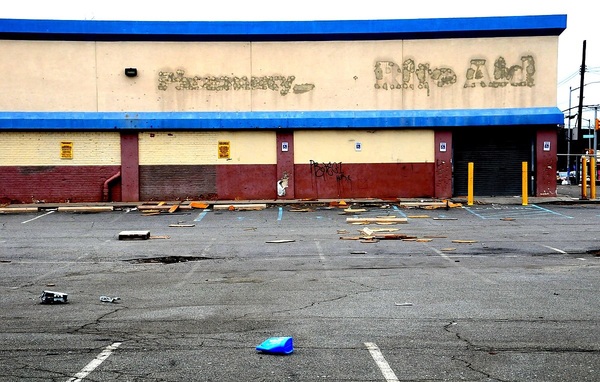
(function(d, s, id) { var js, fjs = d.getElementsByTagName(s)[0]; if (d.getElementById(id)) return; js = d.createElement(s); js.id = id; js.src = “https://connect.facebook.net/en_US/sdk.js#xfbml=1&version=v3.0”; fjs.parentNode.insertBefore(js, fjs); }(document, ‘script’, ‘facebook-jssdk’)); –>
–>
January 26, 2024
About five years ago the only pharmacy in my small town in rural Virginia closed. A year or so later a second county drugstore failed. Soon the owner of the last remaining drugstore in the county was unable to make a profit and had to sell. (These last two managed to reopen at a later date.)
‘); googletag.cmd.push(function () { googletag.display(‘div-gpt-ad-1609268089992-0’); }); document.write(”); googletag.cmd.push(function() { googletag.pubads().addEventListener(‘slotRenderEnded’, function(event) { if (event.slot.getSlotElementId() == “div-hre-Americanthinker—New-3028”) { googletag.display(“div-hre-Americanthinker—New-3028”); } }); }); }
I was unaware the loss of our drugstores was a nationwide trend until reading an article by Karen Kerrigan, president and CEO of the Small Business & Entrepreneurship Council. She reported that mom-and-pop drugstores in rural areas were particularly hard hit, leaving about 630 rural communities with no pharmacy by 2018. Kerrigan reported that the big chains closed nearly 2,000 pharmacies between 2017 and 2020 with more planned. CNN Business reported CVS will be closing another 900 stores in 2024. Walgreens and Rite Aid are also in the process of closing hundreds. You know it’s serious if CNN reported it and is unable to blame Trump.
Competition and the upsurge in shoplifting in soft-on-crime big cities are not the main causes. Kerrigan placed most of the blame on third-party Pharmacy Benefit Managers (PBM). “PBMs negotiate discounts from drugmakers [sic] on behalf of insurers. PBMs also administer reimbursements from the system’s payers — insurers, federal and state governments, and corporations — to providers, including pharmacies and clinics.” Kerrigan added that “PBMs have made the system increasingly complex, enabling them to extract outsized revenue from it while crowding out the small mom-and-pop drugstores.”
There are around 60 companies competing to provide PBM services with three controlling 80% of the market. In 2022 the global market share for PBMs was $495 billion ($315B in the U.S.) and that can buy a lot of political clout. Originally, PBMs were paid by insurance companies to manage drug costs and receive a share of the rebates from manufacturers. Nevertheless, mission creep apparently happened and four other primary income streams were added; pharmacy spread, PBM-owned companies, administrative fees, and direct and indirect remuneration fees.
‘); googletag.cmd.push(function () { googletag.display(‘div-gpt-ad-1609270365559-0’); }); document.write(”); googletag.cmd.push(function() { googletag.pubads().addEventListener(‘slotRenderEnded’, function(event) { if (event.slot.getSlotElementId() == “div-hre-Americanthinker—New-3035”) { googletag.display(“div-hre-Americanthinker—New-3035”); } }); }); }
PBMs have two other devious ways to generate revenue. First by charging a copay higher than the full price of the drug and then ‘claw back’ the overcharge from the pharmacy. Second is by inserting ‘gag clauses ’ in their contracts to prevent pharmacists from advising customers they could save money by not using insurance. It appears many PBMs have abused their power.
Is there legislation to curb the power of PBMs? Thirty-three states have enacted laws to prevent ‘gag clauses.’ In addition, the Senate passed the Pharmacy Benefit Manager Transparency Act of 2022 that prohibits arbitrary ‘clawbacks’ of payments made to pharmacies and making it illegal for PBMs to engage in ‘pharmacy spread’ pricing.
Kerrigan also reported that “…lawmakers across both parties are aware of the plight of local pharmacies and the consequences of their diminishing numbers. This resulted in three dozen bipartisan bills in 2023 that aim to curb the power of PBMs…” However, there is no known evidence to verify if these bills slowed the closing trend.
 Additionally, one earlier bill has already backfired – Biden’s American Rescue Plan Act of 2021. The Epoch Times reported that this bill included a time-delayed rule that went into effect Jan. 1, 2024 changing Medicaid and Medicare part-D drug rebate policy. Until now, these rebates could not exceed the selling price of a drug. Not anymore.
Additionally, one earlier bill has already backfired – Biden’s American Rescue Plan Act of 2021. The Epoch Times reported that this bill included a time-delayed rule that went into effect Jan. 1, 2024 changing Medicaid and Medicare part-D drug rebate policy. Until now, these rebates could not exceed the selling price of a drug. Not anymore.
One unintended result is that the manufacturer GSK will now lose money on each sale of its popular Flovent inhaler for asthma and decided to stop making it. The availability of many other drugs having price increases may be similarly affected. An analysis by AARP found that all the top 25 drugs ordered through Medicare Part-D had tripled in price since entering the market. And these 25 top sellers alone accounted for $80.9 billion in Part-D sales.
PBMs are not the only problem. A local pharmacist placed additional blame on the Federal 340B Drug Pricing Program that began in 1990 when Congress created the Medicaid Drug Rebate Program (MDRP) to lower the cost of pharmaceuticals reimbursed by state Medicaid agencies. Basically, the program works by mandating drug manufacturers to discount their drug prices for covered healthcare entities with a large ‘underserved’ population. Because these discounts hurt drug makers’ bottom line, the 340B program had to limit the number of Federally Qualified Healthcare Centers (FQHC) and qualified pharmacies.
‘); googletag.cmd.push(function () { googletag.display(‘div-gpt-ad-1609268078422-0’); }); document.write(”); googletag.cmd.push(function() { googletag.pubads().addEventListener(‘slotRenderEnded’, function(event) { if (event.slot.getSlotElementId() == “div-hre-Americanthinker—New-3027”) { googletag.display(“div-hre-Americanthinker—New-3027”); } }); }); } if (publir_show_ads) { document.write(“
However, my pharmacist shared that the 340B program is a major contributor to the rise in closures due to a decision in 2010 allowing the number of 340B pharmacies to expand exponentially. According to Foley & Lardner LLP, in 2010, “…the Department of Health and Human Services (HHS) Health Resources & Services Administration (HRSA) issued guidance permitting 340B covered entities to contract with multiple pharmacies if certain conditions were met.” Once that decision was made, “Walgreens went overnight from not having a single contracted pharmacy to having the largest 340B network in the country. They signed up their pharmacies with every possible FQHC plus any qualified hospital in the 340B program.”
This decision increased financial pressure on manufacturers to reduce their 340B pharmacies discounts. Rural stores were first to fail due to the sudden loss of profits. Foley added that by 2020, the impact of the ever-increasing number of drug makers reducing their discounts grew so much that even large chain stores had to either cut staff or close. CNN reported on the closures and declining employee morale and blamed it all on PBMs. CNN totally missed the less obvious 340B contribution that likely caused losses far exceeding those caused by PBMs.
The 340B program is not all bad. It helped rescue the last two pharmacies in my rural Virginia county. The county had two longstanding FQHCs in widely separated small towns and the 340B rules allowed each to contract with or purchase then reopen a previously closed pharmacy. As a result, county residents once again have a local pharmacy, at least for now. Other states with rural areas interested in using this same option can make inquiries at the 340B Contact page.
State level legislation has helped. The Virginia House of Delegates successfully got legislation passed in 2022 that provided some protection from declining pharmacy profits. The sponsor (R) is a pharmacist and told me that without this bill just about every rural FQHC in Virginia would close its pharmacy practically overnight. Coincidentally, he was just appointed to Virginia’s new Select Committee on Advancing Rural and Small Town Healthcare.
The primary cause of loss of profitability is a combination of the growing power of PBMs and perhaps more so to the 340B expansion decision. That’s why my pharmacist had to sell his rural pharmacy and why so many of his colleagues either closed or sold their stores. However, reversing America’s pharmacy death spiral will likely require more than lengthy bipartisan bills written by legislators easily swayed by lobbyists and unfamiliar with this overly complex supply chain. And there is no evidence the pharmacy death spiral has slowed down.
A better solution may be to follow Virginia’s lead and put together a select committee that includes people with actual working experience in the pharmaceutical supply chain. Managed Healthcare Executive described several new free-market innovations by smaller PBMs that could help streamline and standardize the system whereas the big three and most PBMs “…are working on a 30-year-old technology stack.”
Image: Diego Cupolo
<!–
–>
<!– if(page_width_onload <= 479) { document.write("
“); googletag.cmd.push(function() { googletag.display(‘div-gpt-ad-1345489840937-4’); }); } –> If you experience technical problems, please write to [email protected]
FOLLOW US ON
<!–
–>
<!– _qoptions={ qacct:”p-9bKF-NgTuSFM6″ }; ![]() –> <!—-> <!– var addthis_share = { email_template: “new_template” } –>
–> <!—-> <!– var addthis_share = { email_template: “new_template” } –>






